#kifissos
Note
I sometimes will come across paintings of Acropolis and Athens in general from the 19th-20th century and i noticed it had in Acropolis painted a medieval tower which now is not there. What was the purpose of the tower and what happened to it?
Also were there rivers and other demolished monuments in Athens before like in the paintings?
You must mean the Frankish Tower, which was built during the Frankish Occupation around the 13th-14th centuries. After the Crusades, most of the Byzantine Empire was dismantled and many regions became Frankish or Venetian protectorates. Athens was one of them and became the Duchy of Athens. The dukes converted the Propylaea (the ancient gates to Acropolis) into their personal palace and that tower was built as part of that palace. During the Ottoman rule that followed, the Ottomans used this tower as salt store rooms and as prison. In 1874, the Greeks demolished this tower from the ancient site, so the paintings you have seen must be from the 18-19th centuries and not the 20th.

Here is a picture taken in 1870.
Some buildings around the Acropolis in the center of Athens were indeed demolished. When King Otto chose to switch the capital from Nafplio to Athens, Athens was but a tiny muddy village. Otto envisioned bringing Athens back to its former glory and he formed a plan to rebuild it as a neoclassical European capital. Therefore, buildings that did not agree with the Classical aesthetics were removed, mostly peasant houses, some Ottoman buildings and even a few Byzantine Greek churches (not all, some ruins / monuments of both styles remain). On the other hand, Ancient Greek and Roman monuments were preserved.
The river thing is going to be painful. This was something about which I was keeping a post in my drafts but I was getting mad about it every time and never completed it. Prepare for a shitstorm of painful facts. Athens is built on the Attican basin where many streams flow from the hills of the area and from the big mountains of Boeotia and Phocis in the west. In fact, Athens “used to” have 3 main rivers (Kifissós, Ilissós and Irithanós) and 700 (!) streams and creeks (i.e. Elásson and Kyklovóros, mentioning them for no reason other than that I like their names 😅). The former village come metropolis has been the target of an excessive urbanisation in various times in its recent history, most notably in the 60s to 80s time period. As the industries and economy developed, huge numbers of people started abandoning the harsh conditions in remote islands and big mountains for a more comfortable lifestyle in Athens. This caused urgent need for quick mass constructions. Especially during the military junta (1967-1974) uncountable architectural crimes were committed. The urgent need for fast and mass constructions, as well as the lack of scientific research, led to the filling and blockage of most of these rivers. Today only parts of the main rivers and only a handful of the streams are left to flow freely (around 50). Ilissós, the former sacred river of Athens, has been entirely covered and is running underground. We are not talking about Danube or Amazon but we are still talking about an overall waterway blockage worth of 800 km (~500 miles). This is also the reason even a moderate rain can make Athens flood all the time. This waterway blockage has also ruined the flora and fauna of the region. Many Athenians ask that the rivers are uncovered to run free again but the damage done is so excessive that it is too hard to undo at this point. There were “official plans” announced in 2019 about intending to free Ilissós but, you know, I am laughing.

Edward Dodwell, The waterfalls of Ilissos, Athens 1801-1806.

Ilissos river in 1955.
However the war against the river had already started in the ‘30s.
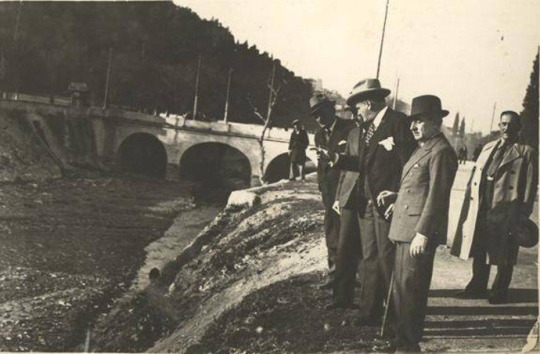
Covering Ilissos, 1937.
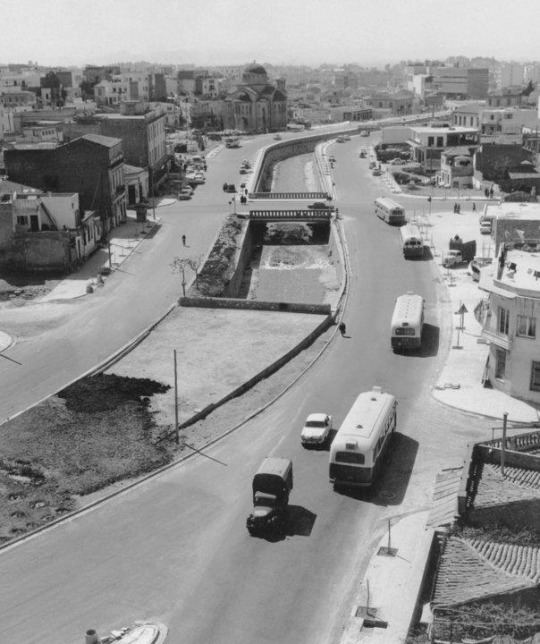
Covering MORE Ilissos river, 1963.
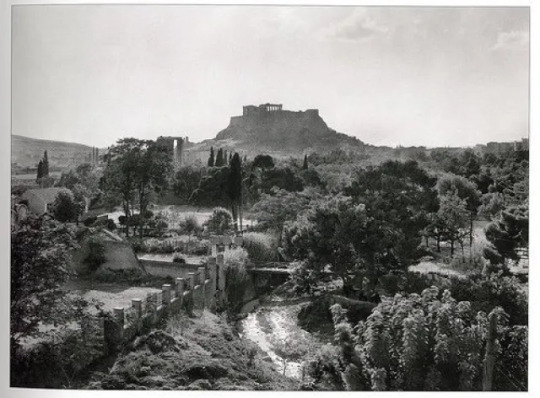
Once upon a time in verdant Athens (1910).
See more photos here.
#greece#history#cities#frankish occupation#river#greek history#athens#ilissos#kifissos#attica#sterea hellas#mainland#anon#ask#greek facts
117 notes
·
View notes
Link

When the city doesn’t go to the village, the village comes to the city. Greeks crowded at the inter-city bus stations in the last couple of days before Easter to receive parcels sent from the villages as the coronavirus restrictions do not allow them to travel there.
Despite the government measure for safety distance, dozens flocked to the bus station of Kifissos in West Athens to receive the parcels from the country side. A few wore masks and gloves but the majority was standing close to each other eagerly looking for the parcel full of goodies.
In nonchalance attitude, they ignored the calls from station employees to keep the necessary distance to each other.
The buses from north, west, south and central Greece had all the traditional food a Greek needs for the festive Easter table.
Lambs, eggs, sweet Easter bread Tsoureki were carefully packed and send to family members and relatives in Athens. Also cans of cheese and olive oil, locally made wine and tsipouro were sent with the bus to soften the bitterness for an Easter celebrations not compared to other.
The buses were empty of passengers and media report that the number of slaughtered lambs was so big that in some cases, the animals had to be placed on the passengers seats.
3 notes
·
View notes
Photo

Rzeka Kifissos. Uosobienie boga Kefisosa, ojca Narcyza.
0 notes
Photo

Kifissos
9 notes
·
View notes
Photo

Kopaida lake ,river Kifissos . by ex80ifcwuv
1 note
·
View note
Photo

kifissos river, Athens
photo Dimosthenis Kapa
#athens#Street Photography#Dimosthenis Kapa#Photographers on tumblr#Black and White#original photographers
39 notes
·
View notes
Photo
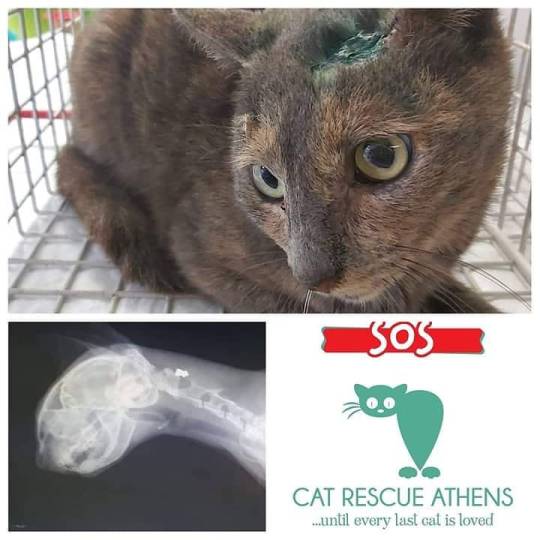
#catsfromgreece #athenscats #lookingforhome #helpagreekstray #saveastrayfromgreece #catadoption #catsofinstagram #kittensofinstagram #adoptdontshop #lifopets #cat_rescue_athens #γάτος #αδέσποτα #αδεσποτακι #γατακι #γατούλης #catfriends #catsofathens #open_cra_cages #tierschutzkatze #tierschutzkatzen #katzensucheneinzuhause 🆘🆘🆘🆘🆘🆘Ενημέρωση για την γατούλα που βρέθηκε στον Κηφισό / Updated on the cat found at Kifisos highway -scroll for English- Είμαστε πραγματικά σοκαρισμένοι καθώς η γατούλα τελικά όπως δείχνει και η ακτινογραφία έχει ΠΥΡΟΒΟΛΗΘΕΊ στο κεφάλι!Το σημάδι που είχε είναι το σημείο εισόδου της ΣΦΑΊΡΑΣ! Δεν γνωρίζουμε τι μπορεί να έχει συμβεί στο γατάκι αυτό και πώς βρέθηκε σε ένα διάζωμα στον Κηφισό πυροβολημένο και με αταξία. Δυστυχώς το σημείο που βρίσκεται η σφαίρα είναι επικίνδυνο για να γίνει χειρουργείο οπότε για την ώρα απλά θα το παρακολουθούμε. Έχει αταξία και κλίση κεφαλής. 🔼Όποιος μπορεί να βοηθήσει με τα έξοδα ας στείλει μήνυμα στη σελίδα μας. 🔼Ψάχνουμε ΥΙΟΘΕΣΙΑ φυσικά για το κακοποιημένο αυτο πλάσμα που δεν μπορεί να γυρίσει στο δρόμο ξανά! We are really shocked as the x rays show finally that the cat has been SHOT in the head! We do not know what may have happened to this poor cat and how she was found in Kifissos highway shot and with ataxia. Unfortunately the point where the bullet is located is dangerous to be operated so for the time being we will just watch it. She has ataxia and head tilt. 🔼If you can help with the medical expenses please pm our page. 🔼We are of course looking for ADOPTION for this abused creature that cannot go back on the road again! (στην τοποθεσία Athens, Greece) https://www.instagram.com/p/B6Lwe6gFsrK/?igshid=ooa8ox94raq3
#catsfromgreece#athenscats#lookingforhome#helpagreekstray#saveastrayfromgreece#catadoption#catsofinstagram#kittensofinstagram#adoptdontshop#lifopets#cat_rescue_athens#γάτος#αδέσποτα#αδεσποτακι#γατακι#γατούλης#catfriends#catsofathens#open_cra_cages#tierschutzkatze#tierschutzkatzen#katzensucheneinzuhause
0 notes
Text
Aegean volunteers battle to turn plastic waste tide
https://sciencespies.com/environment/aegean-volunteers-battle-to-turn-plastic-waste-tide/
Aegean volunteers battle to turn plastic waste tide


In its two years of operation, Aegean Rebreath has amassed 9,000 plastic water bottles, 3,6 tonnes of fishing net and 289 tyres
Dressed in her protective wetsuit and scuba gear, Antigone Kouteri jumps into the murky waters of Zakynthos harbour in search of plastics—and promptly snags her arm on a submerged object.
“It was a tyre,” offers her patrol mate Efthymis, coming up with a discarded beer bottle. “My treat!” he jibes.
The Ionian island of Zakynthos is one of Greece’s most pristine travel destinations, renowned for its azure waters and fabulous beaches, an environment clean enough to be a major Mediterranean nesting ground sought out by loggerhead sea turtles.
But even here, plastic pollution poses a grave threat to wildlife.
Kouteri is one of nearly a dozen volunteers from Aegean Rebreath, a Greek organisation formed in 2017 to protect Aegean biodiversity from waste.
Within three hours, the team has collected four tyres, two shopping carts, a street lamp, metal boxes, plastic bags, dozens of plastic bottles and several kilometres of fishing line.
“Marine litter is a global issue, so it is (present) in Greece. More than 70 percent of marine litter is plastic in Greece,” says Katerina Tsagari, a biologist at the Hellenic Centre for Marine Research near Athens.
Tsagari says her team has found litter, most of it plastic, in about 75 percent of loggerhead sea turtles tested.

WWF has reported that Greece produces 700,000 tonnes of plastic per year, of which 11,500 tonnes end up in the sea
Overall, they have found plastic ingestion in between 20 and 45 percent of the species tested, which include fish and mussels.
With a coastline of some 14,000 kilometres (8,500 miles), one of the longest in the southeastern Mediterranean, Greece attracts tens of millions of tourists every year.
It’s a regional problem. The Mediterranean, a partly closed sea, accumulates 570,000 tonnes of plastic annually from surrounding countries, according to the World Wildlife Fund.
WWF has reported that Greece produces 700,000 tonnes of plastic per year, or 68 kilos per capita. Out of that, 11,500 tonnes end up in the sea, it said.
‘Junkyard’ beneath the waves
“There is a junkyard beneath the blue waters,” says Violetta Walczyk, a Greek-Polish lawyer active with Aegean Rebreath.
On the Cycladic island of Andros, mounds of waste from a 2011 hilltop landfill collapse are still to be found in the sea below.
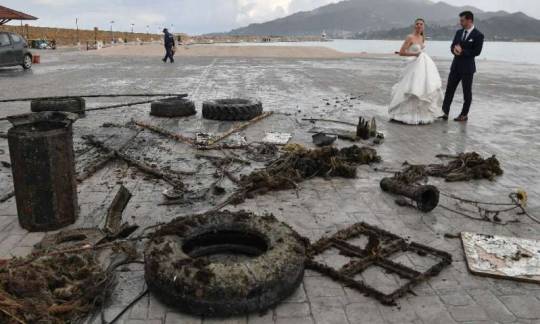
A newly-wed couple looks at the rubbish collected from the sea by volunteers from Aegean Rebreath
In its two years of operation, Aegean Rebreath has amassed 9,000 plastic water bottles, 3,6 tonnes of fishing net and 289 tyres.
The government readily admits that nearly 40 tonnes of plastic waste end up in Greek seas every day.
It recently started a campaign to phase out single-use plastics such as cups and straws—no small feat in a country with a huge coffee-to-go market.
Speaking to AFP last month, Prime Minister Kyriakos Mitsotakis said that marine protection was a “key priority” for a country so dependent on tourism.
Greece continues to pay millions of euros in fines to the European Commission concerning the operation of illegal landfills.
But recycling efforts are still basic. Greece last year eliminated free supermarket bags, long after other European countries.
“Recycling in Greece is a joke,” snorts George Sarelakos, the co-founder of Aegean Rebreath.

Aegean Rebreath, a Greek organisation formed in 2017 to protect Aegean biodiversity from waste
“Every municipality has its own policy, there is no central strategy,” he told AFP.
George Triantafyllou, the HCMR’s head of research, says the institute is coordinating a European project, Claim, across 13 EU countries in addition to Tunisia and Lebanon to eliminate microplastics.
The project includes developing photocatalytic technology to accelerate the degradation of microplastics in seas and rivers, he notes.
The HCMR has also helped develop a floating litter-collection barrier that is currently deployed at the mouth of Kifissos river in Athens.
“I believe everybody should change habits. We don’t have to use plastics in our everyday life,” says George Triantaphyllidis.
Explore further
Researchers warn plastic pollution in Great Lakes growing concern to ecosystem
© 2019 AFP
Citation:
Aegean volunteers battle to turn plastic waste tide (2019, December 1)
retrieved 1 December 2019
from https://phys.org/news/2019-12-aegean-volunteers-plastic-tide.html
This document is subject to copyright. Apart from any fair dealing for the purpose of private study or research, no
part may be reproduced without the written permission. The content is provided for information purposes only.
#Environment
0 notes
Photo

Take a day trip from Athens to Nafplio and discover one of the most picturesque towns in Greece. Here's how to plan your Athens to Nafplio day trip.
Nafplio in the Peloponnese
People visiting Greece often ask about day trips from Athens. Some of the popular choices include the Temple of Poseidon at Sounion, Delphi, and the Saronic islands cruise. One of our favourite suggestions, that often gets overlooked, is the Athens to Nafplio day trip.
Why go to Nafplio?
If you’ve never heard of Nafplio, you will probably wonder what’s so special about it and why you should go there. The short answer is that Nafplio is a charming, picturesque coastal town in the Peloponnese. It has interesting sightseeing, excellent choices for restaurants and accommodation, and lovely beaches all around the area.
The long answer has to do with Nafplio’s rich history and important role throughout the centuries.
A brief history of Nafplio
Nafplio has been a significant Greek port city since ancient times.
The first fortifications of the Akronafplia Castle date from pre-classical times, and all subsequent conquerors, i.e. the Byzantines, the Franks, the Venetians and the Ottoman Empire, fortified and expanded the walls further.
The Venetians also built the castles of Bourtzi, on a little island just off the coast, and Palamidi, up on the hill.
In 1829, after the end of the Greek War of Independence against the Ottoman Empire, Nafplio became the first official capital of the newly founded Greece. In 1834, King Otto decided to move the capital to Athens.
Athens to Nafplio day trip
The easiest way to get from Athens to Nafplio is to take a day trip. This way, your transport is organised for you, and you get to see the most important places in the company of a guide.
Athens to Nafplio by car
As the distance from Athens to Nafplio is only 137 km / 85 miles, most of it being on a modern highway, you can easily drive the Athens to Nafplio route in less than two hours.
You will then get the chance to explore some of the Nafplio attractions, and even to go to one of Nafplio best beaches if you feel like it. If you have plenty of time, you could then continue a road trip in the Peloponnese.
Athens to Nafplio by bus
If you don't want to drive, you can always get a KTEL bus from Athens to Nafplio. Buses depart from Kifissos bus station, and take just around 2 hours 10 minutes to get to Nafplio. Timetables can be found here.
To get to Kifissos bus station, you can either take the metro to Eleonas station and then a quick taxi ride, or just take a taxi directly from your hotel in Athens.
On the way back from Nafplio to Athens, the bus stops at Eleonas metro, so you can hop off there.
What is there to see in Nafplio?
The first thing that will strike you about Nafplio is the imposing castles and walls. You will immediately see the Akronafplia castle, the Palamidi Castle, up on the hill, and the little island close to the coast, which is home to Bourtzi Castle.
Walking around the town, you can’t fail to notice the number of well-preserved neoclassical buildings, souvenir shops and tasteful restaurants.
As the town is built on a hill, there are several levels of it to explore, so put your walking shoes on and get ready to discover Nafplio!
Nafplio Greece things to do
These are some of the specific highlights of Nafplio you should look for.
Akronafplia in Nafplio
Akronafplia is a massive rock that has been inhabited for thousands of years. It is the oldest castle in Nafplio, with the first fortifications dating from the 7th century BC.
During the millennia, all conquerors that passed by Nafplio expanded the walls, with the Venetian constructions of the 14th-15th century being the most important and best preserved ones.
In the years after the Greek Revolution, Akronafplia served as barracks, a military hospital, and eventually a prison, which was demolished in 1970-71 in order for the hotel “Xenia Palace” to be constructed. At that time, parts of the castle were destroyed.
From the top of Akronafplia, there are excellent views of Nafplio town, Argolida Bay and the nearby beaches. To reach the fortress, you can either go through the Catholic Church, or through Arvanitias Square, close to Staikopoulos Park.
Palamidi Castle in Nafplio
Palamidi Castle is the imposing fortress which is located on the hill right above Nafplio. It was built by the Venetians between 1711 and 1714, and was immediately conquered by the Ottomans just after it was completed.
Under the Ottoman rule, Christians were not allowed into Palamidi, until 1822, when a group of Greek rebels took control of the Castle. In the years after the Greek Revolution, Palamidi served as a prison.
One of the unique features of the Palamidi Castle is that it contains eight bastions, connected to each other through a wall.
Each bastion was built to support and defend the remaining seven, while at the same time being self-contained. The bastions were all named, and subsequently renamed by each conqueror.
Apart from the bastions, visitors can see the chapel of Agios Andreas and a set of water tanks, used until today to collect rainwater. According to legend, there was a secret passage connecting Akronafplia with Palamidi Castle in Nafplio.
Palamidi Castle offers amazing views over the Bay of Argolida, the town of Nafplio and Akronafplia Castle.
It is possible to hike up Palamidi through a staircase of over 900 steps – the exact number is debated, with locals claiming that they are 999. If you don’t feel super keen on climbing those steps, there is also an asphalt road.
Opening hours vary between summer and winter, so check the official website before you visit.
Bourtzi Castle in Nafplio
The Venetian “Castle of the throne”, renamed to “Bourtzi” by the Ottomans, is perhaps the best known landmark of Nafplio. It was built in 1473 on the tiny island of Agii Theodori in the Argolida Bay, as an additional fortification to the Akronafplia Castle, to which it was connected through a heavy chain.
In recent years it served successively as a prison, a residence for executioners, the head offices of the Greek National Tourism Organization, a luxury hotel / restaurant and a café.
It was abandoned around the mid-80s, and has been closed to the public ever since. Ongoing restoration works of the historic castle started in 2013, and at the moment there is no information as to when Bourtzi will open to the public.
Small boats departing hourly from the dock on weekends can take you to the island. The round trip costs 4,50 euro and lasts for around a half hour, during which you can go for a brief walk around the castle. Not sure if it’s worth it really!
If you were looking for a more active way to visit Bourtzi, you might want to consider a kayak tour of Nafplio.
Tiryns
The nearby archaeological site of Tiryns, just a few kilometres down the road, is also highly recommended. Tiryns has achieved joint UNESCO site status in Greece along with Mycenae (a nice day trip from Nafplio!).
This fortified area would have played an important role in the Mycenaean world. Its imposing walls are worth walking around, and you should allow an hour or two to see the site in full.
Other important sites in Nafplio – Nafplio things to do
After the Greek Revolution, the city of Nafplio was redesigned and rebuilt. Parts of the old Akronafplia Castle and certain Ottoman buildings were destroyed, and new buildings, squares and the train station were constructed in their place.
In the centre of Nafplio, you will see Syntagma (= Constitution) Square, where the Ottoman pasha’s Palace used to stand in the 16th century.
Close to Syntagma Square you will see the Archaeological Museum of Nafplio, a couple of mosques, a building that served as prison in the past and is now an annex of the Archaeological Museum, and several other important buildings and churches.
The Trion Navarhon Square, which is close by, is also surrounded by excellent buildings, such as the City Hall, several important churches and a few mansions. Nafplio is dotted with statues of several people who were important in the city’s long history.
Walking tour of Nafplio
There are several other notable buildings, not only in the immediate centre of Nafplio, but also in the outskirts and suburbs.
If you have a special interest in Greece’s recent history and architecture, consider taking a walking tour of the town, which will offer some more insight.
Nafplio what to do – Beaches in Nafplio
As Nafplio is a coastal town, once you’re done with climbing stairs and walking around the town, you can go for a refreshing swim. The temperatures in Nafplio are relatively mild all year round, so you might be able to swim even if you visit Nafplio in autumn or winter.
Arvanitia Beach is just underneath Palamidi Castle, a 10-15 minute walk from central Nafplio. Even if you are on a quick Nafplio day trip from Athens, you have plenty of time for a splash. There is a beach bar, umbrellas, loungers and showers, so it’s the ideal place to have a relaxing break from sightseeing.
Further down from Arvanitia, you can find Karathona beach. You can reach it by a lovely hike from central Nafplio or a quick ride by bicycle or car. It is a long, sandy beach, especially popular with families due its shallow, crystal clear water. It gets quite busy during summer and particularly during weekends, but if you are visiting Nafplio on a spring weekday you might almost have the beach to yourself.
There are several more beaches around Nafplio, especially close to Tolo town, which is further down on the coast. If you decide to stay longer around Nafplio and have your own transportation, Tolo can actually be a good base. You can then explore the nearby beaches of Tolo / Psili Ammos, Kastraki, Plaka and Agios Nikolaos / Kondili.
Hotels in Nafplio
While Nafplio day trips from Athens are extremely popular, Nafplio is also a great base if you want to visit further away areas in the Peloponnese. You can either only spend one night in Nafplio, or base yourself there for a few days and take day trips to other places.
There are plenty of accommodation options in the old town of Nafplio as well as the suburbs. If you want to stay right in the middle of everything, take a look at the map of hotels in Nafplio below.
Booking.com
(function(d, sc, u) { var s = d.createElement(sc), p = d.getElementsByTagName(sc)[0]; s.type = 'text/javascript'; s.async = true; s.src = u + '?v=' + (+new Date()); p.parentNode.insertBefore(s,p); })(document, 'script', '//aff.bstatic.com/static/affiliate_base/js/flexiproduct.js');
Stay at Tolo
At the same time, if you think that a Nafplio day trip from Athens is too short (it is!), you can stay in the area longer and drive around. In this case, you can also base yourself in nearby Tolo.
We have stayed at Hotel Solon, which was quite basic, but it’s right on the beach, plus there is an interesting story behind it. As it was one of the first hotels in the area, many Greek actors who worked at Epidaurus Festival (more on this below) have stayed here in the past.
Travel Tip: As the Athens to Nafplio distance is small, Nafplio is a popular weekend trip for Athenians. If you want to extend your Nafplio day trip to a couple of days and are going on a weekend, make sure you book your accommodation in advance.
Nafplio day trips
If you decide to base yourself in Nafplio for a few days, you have many options for day trips from Nafplio. The obvious ones are Nafplio to Epidaurus, and Nafplio to Mycenae.
It is a half hour’s drive from Nafplio to Epidaurus, known in Greek as Epidavros. Epidaurus is famous for its massive ancient theatre,. It was built in the 4th century BC and has some of the best acoustics in the world.
The Epidaurus theatre can seat up to 14,000 people, and hosts the Epidaurus Festival showing ancient Greek plays on summer weekends.
In modern days, Epidaurus theatre has been hosting plays since 1954. Most of the plays are in Greek, and the actors who have played are well known around Greece. Occasionally, foreign artists are invited to the Epidaurus theatre. An example is Kevin Spacey who performed as Richard the 3rd in 2011.
If you are not interested in a show at the theatre, you can still visit the theatre and the Sanctuary of Asklepios during the day. The experience of a show in the Epidaurus theatre will stay with you for years though!
Mycenae UNESCO Site
On your way back to Athens, you can stop at the archaeological site of Mycenae. This is one of the most important archaeological sites in Greece.
As the Nafplio – Athens distance is not long, and normally takes just under two hours by car, you have plenty of time to explore the ancient site. Get ready for some uphill and hiking, and allow enough time in the museum.
If you are interested in wine, consider taking a day trip from Nafplio around the Nemea area, where Hercules killed the Nemea Lion, and indulge in some wine-tasting.
Final thoughts on Nafplio day trip
Conclusion – while Nafplio is a great day trip from Athens, try to spend a night or more in the town. The area has plenty to do and see, and you will definitely enjoy your time spent in the first Greek capital.
The post Athens to Nafplio Day Trip – Visit Nafplio in the Peloponnese Greece appeared first on Dave& Travel Pages.
#url=https%3A%2F%2Fwww.davestravelpages.com%2Fathens-to-nafplio-day-trip%2F&title=Athens%20to%20Nafplio%20Day%20Trip%20%E2%80%93%20Visit%20Na#039;s
0 notes
Text
Houses, shops and streets were flooded and people were trapped in their homes and vehicles in southern Athens when a rainstorm hit on Tuesday night. The Fire Service received dozens of calls for help. Note that the flooded areas Kallithea, Moschato, Neo Faliro are right next close to a construction “anti-flooding” project that has been going on for over two years.
Flooded were parts of main roads like Posidonos Avenue along the Athens Riviera at the height of Faliron Delta, the south part of Syggrou Avenue connecting the south suburbs with downtown Athens as well as parts of Petrou Ralli avenue and parts of Kifissos Avenue in Tavros suburb.
0 notes
Photo

#walkingforsanity No1 #reflections #riverunderneath #kifissos #athens #ingoodcompany
0 notes
Photo

kifissos river, Athens
photo Dimosthenis Kapa
102 notes
·
View notes
Photo
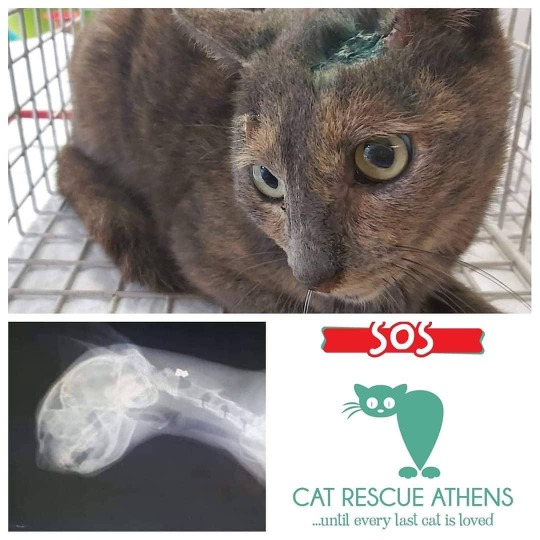
#catsfromgreece #athenscats #lookingforhome #helpagreekstray #saveastrayfromgreece #catadoption #catsofinstagram #kittensofinstagram #adoptdontshop #lifopets #cat_rescue_athens #γάτος #αδέσποτα #αδεσποτακι #γατακι #γατούλης #catfriends #catsofathens #open_cra_cages #tierschutzkatze #tierschutzkatzen #katzensucheneinzuhause 🆘🆘🆘🆘🆘🆘Ενημέρωση για την γατούλα που βρέθηκε στον Κηφισό / Updated on the cat found at Kifisos highway -scroll for English- Είμαστε πραγματικά σοκαρισμένοι καθώς η γατούλα τελικά όπως δείχνει και η ακτινογραφία έχει ΠΥΡΟΒΟΛΗΘΕΊ στο κεφάλι!Το σημάδι που είχε είναι το σημείο εισόδου της ΣΦΑΊΡΑΣ! Δεν γνωρίζουμε τι μπορεί να έχει συμβεί στο γατάκι αυτό και πώς βρέθηκε σε ένα διάζωμα στον Κηφισό πυροβολημένο και με αταξία. Δυστυχώς το σημείο που βρίσκεται η σφαίρα είναι επικίνδυνο για να γίνει χειρουργείο οπότε για την ώρα απλά θα το παρακολουθούμε. Έχει αταξία και κλίση κεφαλής. 🔼Όποιος μπορεί να βοηθήσει με τα έξοδα ας στείλει μήνυμα στη σελίδα μας. 🔼Ψάχνουμε ΥΙΟΘΕΣΙΑ φυσικά για το κακοποιημένο αυτο πλάσμα που δεν μπορεί να γυρίσει στο δρόμο ξανά! We are really shocked as the x rays show finally that the cat has been SHOT in the head! We do not know what may have happened to this poor cat and how she was found in Kifissos highway shot and with ataxia. Unfortunately the point where the bullet is located is dangerous to be operated so for the time being we will just watch it. She has ataxia and head tilt. 🔼If you can help with the medical expenses please pm our page. 🔼We are of course looking for ADOPTION for this abused creature that cannot go back on the road again! (στην τοποθεσία Athens, Greece) https://www.instagram.com/p/B6LtJl3lmoj/?igshid=1xj7rayl3lu4f
#catsfromgreece#athenscats#lookingforhome#helpagreekstray#saveastrayfromgreece#catadoption#catsofinstagram#kittensofinstagram#adoptdontshop#lifopets#cat_rescue_athens#γάτος#αδέσποτα#αδεσποτακι#γατακι#γατούλης#catfriends#catsofathens#open_cra_cages#tierschutzkatze#tierschutzkatzen#katzensucheneinzuhause
0 notes
Text
Ο Ελαιώνας ως μία άλλη ‘Αρμίλα’: Μία διεπιστημονική σύγκλιση
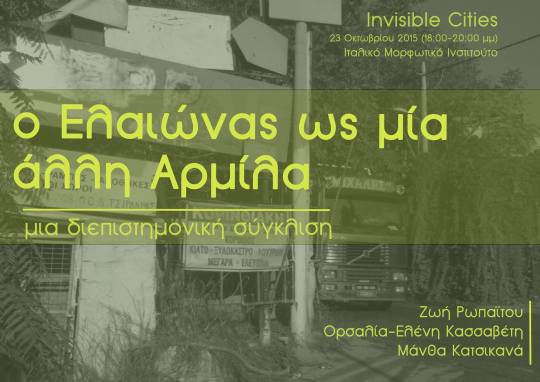
Ο Ελαιώνας ως μία άλλη Αρμίλα: Μία διεπιστημονική σύγκλιση
Παρουσίαση στη διεπιστημονική - καλλιτεχνική διημερίδα “Αόρατες Πόλεις” / Invisible Cities (23 Οκτωβρίου 2015). Διοργάνωση Τμήμα Επικοινωνίας και ΜΜΕ (ΕΚΠΑ) - Ιταλικό Μορφωτικό Ινστιτούτο Αθηνών
Ζωή Ρωπαΐτου, Ορσαλία-Ελένη Κασσαβέτη, Μάνθα Κατσικανά
Με μια πρώτη ματιά, ο χαρακτήρας της περιοχής του Ελαιώνα μοιάζει να είναι ακαθόριστος και παγιδευμένος μεταξύ παρελθόντος και παρόντος, θυμίζοντας την πόλη Αρμίλλα του Καλβίνο: μία πόλη ημιτελή και ημικατεστραμμένη, εγκαταλελειμένη προτού καν κατοικηθεί ή λίγο αμέσως μετά από την πρώτη κατοίκησή της. Στο παρελθόν, ο Ελαιώνας, ως αγρο-κτηνοτροφική περιοχή, φιλοξενούσε συγκεκριμένες ταυτότητες, αφηγήσεις και πρακτικές της καθημερινότητας. Στη σύγχρονη εποχή πια, το παρελθόν έχει αφήσει το στίγμα του χωρικά με ίχνη, θραύσματα και άδεια κελύφη ενός ημιθανούς λαϊκού πολιτισμού. Σε συνδυασμό με την εγκατάσταση της βιομηχανίας και τη συνεχή ροή των κοντινών οδικών αξόνων, ο Ελαιώνας πλησιάζει περισσότερο σε μία ιδιαίτερη μορφή αυτού που ο Οζέ ονομάζει μη-τόπο. Προσπερνάται και βιώνεται αποσπασματικά μέσα από περάσματα και ημι-κατεστραμμένα επιβιώματα μίας άλλης εποχής. Παραγκωνισμένος συστηματικά από τις διάφορες χωρικές και αναπτυξιακές πολιτικές, ο Ελαιώνας αντιμετωπίζεται σαν ένας χώρος εναπόθεσης ετερόκλητων και συχνά ανεπιθύμητων αστικών χρήσεων γής που καλούνται να συνυπάρξουν με την παρούσα καθημερινότητα του τόπου. Με τη χρήση των αφηγήσεων ζωής, της οπτικής εθνογραφίας και της σύγχρονης σκέψης για τη ζωή στην πόλη, η παρούσα διεπιστημονική προσέγγιση έχει ως σκοπό να παρουσιάσει όψεις μίας υπαρκτής Αρμίλας, η οποία βρίσκεται σε απόσταση αναπνοής από το κέντρο της Αθήνας.
Στο πλαίσιο της παρουσίασης, πραγματοποιήθηκε προβολή του εθνογραφικού βίντεο Αρμίλα: τι φυτρώνει εδώ διάρκειας7 λεπτών σε καταγραφή Ο.-Ε. Κασσαβέτη - Μ. Κατσικανά και αφήγηση Ζ. Ρωπαΐτου με αποσπάσματα από το βιβλίο της “Ο Ελαιώνας της Αθήνας” (Αθήνα, Εκδόσεις Φιλιππότη, 2006). Ένα απόσπασμα του βίντεο βρίσκεται παρακάτω, καθώς κι ένας χάρτης με σημεία ενδιαφέροντος των αφηγήσεων ζωής.

vimeo
2 notes
·
View notes
Photo

Kifissos river, Athens
photo Dimosthenis Kapa
26 notes
·
View notes
Text
Η επανεμφάνιση του κόσμου ως μια λαϊκή φυσιολογία. Το Κάτω Αιγάλεω.
Δεν μετριάζεται. Η γνώση, η παραδοχή και η συγκατάβαση δεν επαρκούν για την κατασκευή και της πιο απλής λαϊκής φυσιολογίας, μιας φυσιολογίας ευπροσήγορης και επιτακτικά αποκωδικοποιήσιμης. Ο κόσμος που γνωρίζουμε στην ουσία επαναδημιουργείται πίσω από τις τζαμαρίες και τα κλειστά στενά, γυρνά αδηφάγα να ανοίξει σειρές από βαριά τσιμεντένια θεμέλια - ωστόσο, τίποτε δεν μπορεί να θεμελιωθεί πάνω στο μη καταχωρημένο τίποτα. Και μιλάω για ότι οι χάρτες τύπου Καπρανίδη ονοματίζουν ως “Κάτω Αιγάλεω”.






Το Κάτω Αιγάλεω τοποθετείται νότια από το επίσημο συγκοινωνιακό κέντρο της περιοχής (βλ. Σταθμό μετρό “Αιγάλεω”), σε μια ατέρμονη ευθεία που ξεκινά από τη μέση περίπου του γνωστού σε όλους ποταμού. Δεν υπάρχει ρυμοτομία, δεν υπάρχει ευρρυθμία: παρόλο που οι γνωστές αντιπροσωπίες οχημάτων από το ύψος της λεωφόρου Αθηνών-Καβάλας έως και την Ιερά οδό επιμένουν προσόψια, η σταθερή κατηφορική κλίση του δρόμου επιβεβαιώνει ένα υπέροχο, αυθύπαρκτο τίποτα, το οποίο δεν καταχωρείται παρά στη λαϊκή μνήμη των κατοίκων του, γιατί μόνο εκεί υπάρχει ζωή.





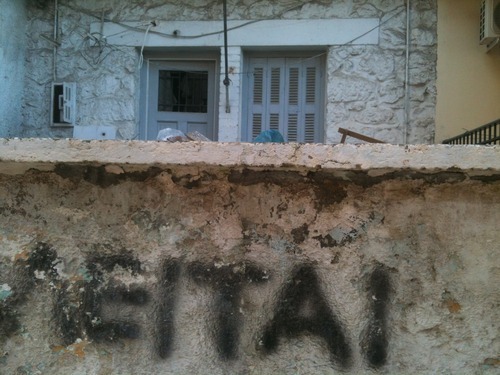







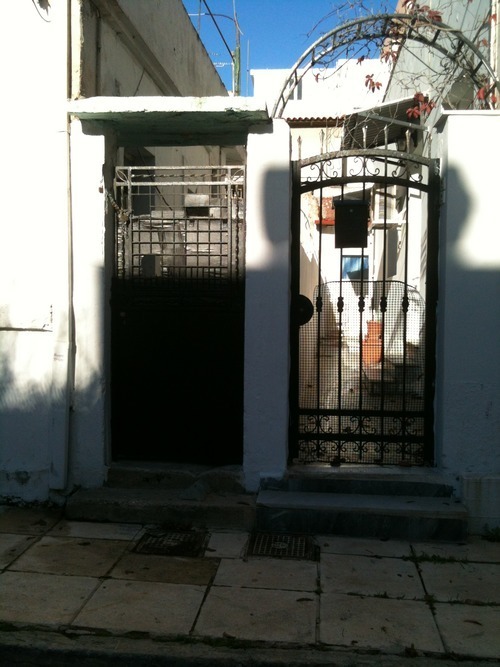

Η πλατεία των Αστροναυτών, η οδός Ανδριανουπόλεως, η άθικτη πρωτόγονη κατοικία, οι ελάχιστες μάντρες, ο χαμηλός ορίζοντας.
Χώρους κοινωνικής διάδρασης δεν είδα, μόνο κουτσουρεμένες παιδικές χαρές και μαγαζιά-τζαμαρίες. Δεν νομίζω να έγιναν ποτέ μαγαζιά, δεν πρέπει να λειτούργησαν ποτέ τους.
Όσο περπατούσα προς τα Δυτικά, όσο οι δρόμοι προσέγγιζαν τη λεωφόρο Θηβών, τα σπίτια έστεκαν διόρωφα διακοσμημένα με φαντεζί χρωματισμούς και οι κάτοικοί τους τολμούσαν να βγουν στο δρόμο, τολμούσαν στην ύπαρξη, διεκδικούσαν την αυθυπαρξία μαζί με μια στέρεη συνείδηση, θέλοντας στ’ αλήθεια να αλλάξουν το σύστημα απεικόνισής τους.
Ξαναθυμάμαι τον Λουκάτο που εξήρε τη φυσιολογία των “φαινομένων που μπορούμε να πούμε ότι στηρίζονται στον νόμο του πρωταρχικού λαϊκού στοιχείου των πολιτισμών, ένα νόμο που αποδείχνει ότι η οποιαδήποτε αστική εξέλιξη των κοινωνικών σχέσεων, των εθίμων και των συμβολισμών έχει πυρήνα και κίνητρό της την πρωτογενή αντίστοιχη λαογραφική ενέργεια”. Ίσως κι ενός αόρατου τελετουργικού για να επανεμφανιστεί η περιοχή τους στο χάρτη. Και τα σπίτια τους.
Η Ιερά οδός. Η μέση οδός. Το τίποτα.
1 note
·
View note